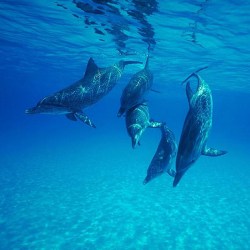Dolphins Are Right Sided Mammals

New research shows that dolphins are similar to humans in that their right-hand side tends to dominate. In humans approximately 90 per cent of people are right-handed. Gorillas also tend to be right-handed whilst kangaroos favour their left and cats also favour particular sides depending on their gender. Researchers have now shown that bottlenose dolphins tend to display an even stronger preference for their right side than humans.
Unexpected results
Experts says they did not expect to find that kind of behaviour nor such strong examples. When studying the species in the Bahamas they say the preference is exhibited in crater feeding. This is when dolphins hug the seabed, echolocating for prey before shoving their snouts into the sand to snag an easy meal. Researchers says dolphins make a sharp and sudden turn before digging in. This turn is almost always to the left in 99 per cent of the 709 turns recorded in the six years ending 2018.
Strong evidences
The results of the studying suggest right-side bias because turning left ensures the dolphin’s right side and its right eye remain close to the ocean floor. Only four turns during the period were made to the right and all came from the same dolphin which also had an unusual shaped pectoral fin which experts says is unlikely to be the reason for that behaviour.
Other species are similar
This is not the first-time researchers have found evidence of right-side bias in cetaceans. Other species such as grey and humpback whales also display right sided bias. Researchers think the reasons behind the bias is that it makes it easier for dolphins to swallow prey because the food channel splits around the larynx is wider on the right than on the left side. Another possible reason is the echolocating clips are produced with phonic lips located on the right side of their head, though more evidence is needed to prove that.
Hemisphere processing
The nearly blind Ganges river dolphin for example relies heavily on echolocation and always swim right side down. Brain processing could be another factor. As is the case with humans, sensory information collected by one side of the body is processed by the other side of the brain. If echolocation information is primarily processed by the dolphin brain’s left hemisphere, they would naturally tend to prefer to use their right eye and ear.
.



